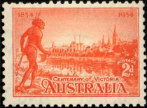History
Timeline results for victoria
Found 60 results for your search. Showing page 1 of 3.
Search terms: victoria, year from 1400, year to 2021
1600
-
Bone tool deposits at Otway Peninsula, Victoria suggest Aboriginal people were working with animal skins.
1830
-
Port Phillip District Wars rage in Victoria (then administered by New South Wales and known as Port Phillip district) from 1830 to 1850. The Indigenous Koorie population resists the large influx of immigrants and settlers who bring large herds of sheep and cattle into the state.
1835
-
Victoria has a so-called treaty with Wurundjeri people, covering land from Geelong to Melbourne. One of Melbourne's founders, John Batman, presents deeds which claim to have signed over the land in exchange for axes, flour and other European goods. But the agreement (now also called 'Batman's treaty') is almost immediately overturned by New South Wales Governor Sir Richard Bourke, as NSW was the overseeing colonial government of the area.[1]
1841
-
30 Aboriginal people massacred at Rufus River in New South Wales, close to the boundaries with Victoria and South Australia.
1842
-
Governor Bourke of NSW orders the establishment of the Native Police in the Port Phillip district (now Victoria). Aboriginal troopers, trained to track and disperse groups of Aboriginal people, are part of the force. It is disbanded in 1853.
1868
-
An an all-Aboriginal cricket team of men from lands of western Victoria embarks on a tour of England, backed by private financiers.
1869
-
Victorian Board for the Protection of Aborigines is established. The Governor can order the removal of any child to a reformatory or industrial school. The Protection Board can remove children from station families to be housed in dormitories. Later similar legislation is passed in other colonies: New South Wales (1883), Queensland (1897), Western Australia (1905) and South Australia (1911).
-
Victorian Board for the Protection of Aborigines is established. The Governor can order the removal of any child to a reformatory or industrial school. The Protection Board can remove children from station families to be housed in dormitories.
Later similar legislation is passed in other colonies: New South Wales (1883), Queensland (1897), Western Australia (1905) and South Australia (1911). The Northern Territory Aboriginals Ordinance makes the Chief Protector the legal guardian of every Aboriginal and 'half-caste' person under 18. Boards are progressively empowered to remove children from their families.
1885
-
John Batman negotiates a treaty with the Kulin people but this was declared invalid by the Governor of Victoria as it was carried out by a private citizen rather than the Crown. Little more was heard of treaties for nearly 100 years.
1886
-
The Victorian Aborigines Protection Act excludes ‘half-castes’ from their definition of an Aboriginal person. As a result nearly half the residents of the missions and reserves have to leave their homes.
-
Victorian Board for the Protection of Aborigines is empowered to apprentice Aboriginal children when they reach 13. Children require permission to visit their families on the stations.
-
Men and women of the Coranderrk Aboriginal Reserve (60 kms north-east from Melbourne) fight the Aboriginal Protection Board which wants to break up the successful community that’s growing hops and doing better than neighbouring white farms. Walking to Melbourne, they deliver a petition to the Victorian government. But the majority of the residents are removed under the Protection Act which cripples Coranderrk as an enterprise. The government closes it in 1924.
1910
-
The Victorian Aborigines Act permitted the Board for Protection of Aborigines to help ‘half-castes’ by licensing needy persons to live on stations.
1930
-
Victorian Yorta Yorta man William Cooper petitions the King to have an Aboriginal representative in the federal House of Representatives, the main chamber of the national Australian parliament. A similar attempt is made in NSW. They are unsuccessful.
1934
-

One of the earliest Australian stamps with a reference to Aboriginal culture. The 1934 stamp issue shows an Aboriginal man with spears walking towards a river that separates him from the town beyond, almost as if to show the contrast between pre and post invasion conditions. There were three denominations to the set.
1939
-
The first-ever mass strike of Aboriginal people in Australia occurs, called the Cummeragunja Walk-off. Over 150 Aboriginal people pack-up and leave Cummeragunja Aboriginal Station in protest at the cruel treatment and exploitation of residents by the management. They walk 66kms and cross the border from New South Wales into Victoria in contravention of the rules of the New South Wales Protection Board. The opera Pecan Summer tells the story of the walk-off.
1942
-
Darwin is bombed by the Japanese. In Arnhem Land, Aboriginal people make up a special reconnaissance unit in defence of Australia. Northern Territory Aboriginal missions are evacuated. Many Aboriginal people evacuated after the bombing are transferred to ‘control camps’ in Victoria, South Australia or New South Wales and some never return. Restrictions are placed on Aboriginal movement, especially of women.
1951
-
The federal government convenes the Australian Conference for Native Welfare, with all states and territories represented except Victoria and Tasmania, which claim to have no Aboriginal ‘problem’. The conference officially adopts a policy of ‘assimilation’ for Aboriginal people.
"Assimilation means, in practical terms, that it is expected that all persons of Aboriginal birth or mixed blood in Australia will live like white Australians do." [2]
1957
-
Victorian Aborigines Welfare Board replaces the Board for the Protection of Aborigines. The Welfare Board is abolished in 1967.
1976
-
Victorian Aboriginal Child Care Agency is established, rapidly achieving a 40% reduction in the number of Aboriginal children in children’s homes. It is followed by the South Australian Aboriginal Child Care Agency (1978), Karu in Darwin (1979) and the Western Australian Aboriginal Child Care Agency (1980).
